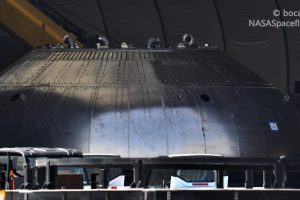A SpaceX Super Heavy booster was rocked by a substantial explosion and subjected to multiple fires at the launch pad during the rocket’s latest round of testing.
As of 9 pm CDT, July 11th, the fate of the upgraded Super Heavy – known as Booster 7 or B7 – is leaning towards survival but and it won’t be certain until the rocket is drained of all cryogenic propellant and potentially flammable gas and safe for SpaceX employees to approach. The incident began around 4:20 pm CDT, when Super Heavy Booster 7 (or its launch mount) unintentionally ignited a cloud of flammable gas produced during flow test involving most or all of its 33 Raptor engines. In the past, SpaceX has performed “spin prime” tests with Raptors installed on Starship prototypes, flowing high-pressure gas through the engines’ turbines to get them up to operating speeds and pressures. Booster 7’s test ended a bit differently.
When the resulting cloud of well-mixed methane and oxygen gas was accidentally ignited, it functioned like a small fuel-air bomb, rapidly combusting to produce a violent explosion and shockwave. After the initial explosion, the fire also expanded to burn as much of the resulting gas as possible, producing a fireball that briefly reached 80-90 meters (~260-300 ft) in height. CEO Elon Musk – apparently not directly participating in the test – initially stated that the explosion and fire was planned, implying that it was more or less a nominal outcome. Virtually everyone with experience observing Starship testing felt otherwise, however.

To preserve the safety of the few local residents still living at Boca Chica Village, SpaceX is required to issue printed safety warnings well in advance of Starship tests that could create a shockwave capable of shattering glass and injuring locals. SpaceX has never intentionally performed such a test without distributing those warnings and did not distribute a warning before July 11th, all but guaranteeing that no ignition event was planned. A few hours later, Musk deleted his original tweet and posted a different one, confirming that the explosion was “actually not good” and that SpaceX is “assessing the damage.”
For the most part, Booster 7 and the Starbase Orbital Launch Site (OLS) exceeded viewers’ expectations of their sturdiness, exhibiting very little off-nominal behavior after being subjected to a unexpected explosion, shockwave, and fire. Immediately after the event, B7 quickly depressurized its propellant tanks and appeared to leave those vents open, reducing the chances of the booster destroying itself if SpaceX were to lose control. SpaceX also appeared to intentionally avoid using the orbital launch mount’s (OLM) umbilical mechanism to remove propellant from the Super Heavy’s tanks, perhaps concerned that the shockwave might have weakened its connection to B7.
About an hour after the explosion, Booster 7 dumped a large amount of cryogenic liquid out of a new vent located on its aft end, producing a flood that spread around the adjacent pad. It’s unclear if that liquid was nitrogen or oxygen but either way, the emergency propellant dump appeared to cause a fire to start about 100 feet (~30m) from the booster and launch mount. That fire proceeded to burn intermittently for the next two hours, all the while posing a clear and present danger to the rest of the pad and booster if it were to spread in the wrong direction or breach the wrong underground pipe. Instead, SpaceX got lucky and the fire eventually self-extinguished.
In a worst-case scenario, Super Heavy’s engine section and 33 Raptor engines could have been seriously damaged, while the subsequent pad fire(s) could have also significantly damaged crucial pad systems, requiring weeks of repairs. The booster could even be beyond repair. More optimistically, given that SpaceX appears to have gotten lucky enough to avoid a total loss of vehicle, Booster 7 may be fine after some inspections and moderate repairs. The pad damage could also be limited to a single isolated, non-critical piece of equipment catching fire and burning to a crisp
Regardless, SpaceX will need to figure out what exactly caused the explosion and make sure that that failure mode does not appear again. In the meantime, the company recently finished stacking Super Heavy Booster 8, and Starship S24 – installed on a nearby suborbital test stand – is ready to begin its own static fire test campaign in the near future.





